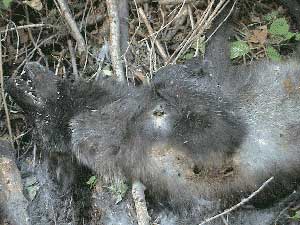In August 2001, during the second college wolf class for the summer, I kept
catching the scent of a dead animal each time I drove by a particular area
on the main dirt road that lead to and from our base camp. At the
time, we were looking for the wolves' next kill site, and I was hoping
this was it. With the help of the students, we searched the area
and found that the stench had come from a dead wolf pup. It
had been shot and was laying in the ditch next to the road under some foliage.
 |
The pup was a black female and approximately four
months old. The entry and exit wounds produced by the bullet could
easily be seen, demonstrating that it had been shot. The pup was
found approximately two miles from the current rendezvous site at that
time. This worried all of us since we did not want our research
activities to inadvertently indicate the location of the wolf pack and
give those who wished to shoot wolves an opportunity to do so again. However, after gathering as much data as we could, the shooting of this
pup seemed to be an opportunistic event by someone who just happened to
be in the "right place at the right time."
Part of the summer classes was to expose students to the
realities of life here in northwest Montana by having them interact with
ranchers, biologists, and the general public when the opportunities arose. Sometimes, "things just happened" which occurred to both summer wolf classes during this particular August. Several students from the first class actually observed many of the adults
and pups resting and playing on and next to the road. These observations,
along with the data from the previous winter, helped determine that there were eight
members of the Fishtrap pack at the time: fours adults and four pups. The
students in the first class expressed a concern that the wolves could be easily
seen by the public. Since the prejudice against wolves can be high in
northwest Montana, they were worried that the wolves were at risk of getting shot. The second class, of course, found this to be true.
Although gray wolves at the time were protected by the Endangered Species
Act, the shooting deaths of wolves in northwest Montana had not been uncommon.
It is part of the local communities' resistance to Wolf Recovery, and is
an extension of the inherent bigotry and fear of predators in the culture
of northwest Montana and other places.
Several years before the this pup incident, I received
a letter from a rancher who had befriended myself and the students in previous
wolf classes. He had lived in a nearby valley
that had several ranches. Having spent a great deal of time in this
particular area in the past, I have found that many of these people do
not like wolves. My friend is in the minority in that he is a rancher
and is actually "pro-wolf." I am also friends with ranchers who are
"anti-wolf" which helps me understand more of where this hatred is coming
from. My ranching friend's letter explained that over a year's time
he knew of at least five wolves that had been shot by members of the local
community and then buried to hide the evidence. This amounted to an
entire wolf pack.
Although my friend's valley was not part of the
Fishtrap pack's territory, his letter helped demonstrate that the shooting of wolves,
protected or not, is not only a local phenomenon. It occurs all over
and is one of the many issues that Wolf & Wildlife Studies is trying
to correct through research and education.